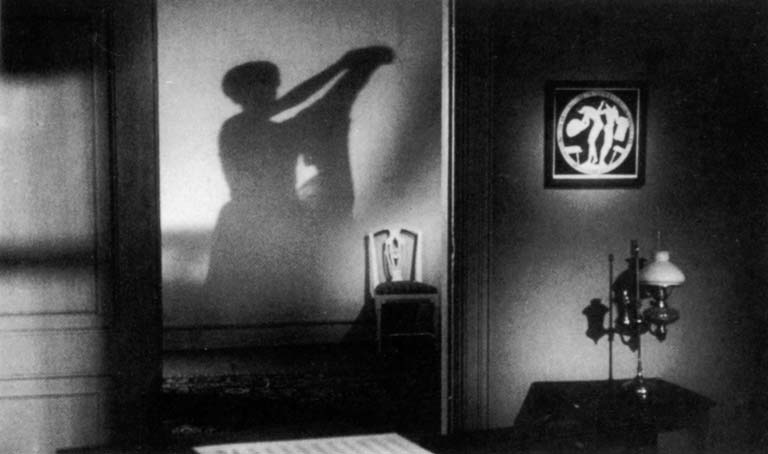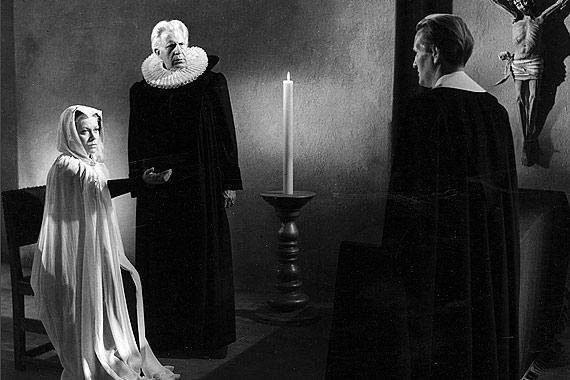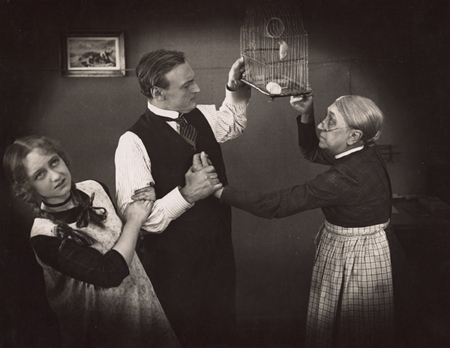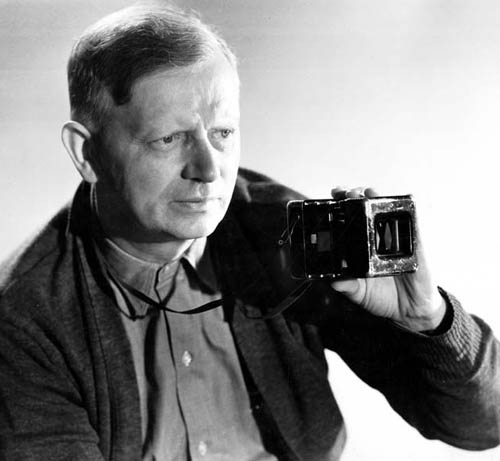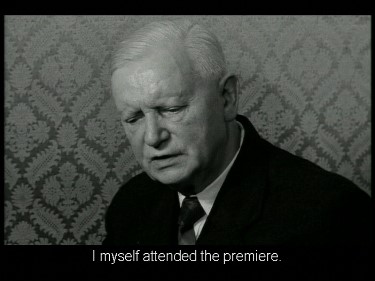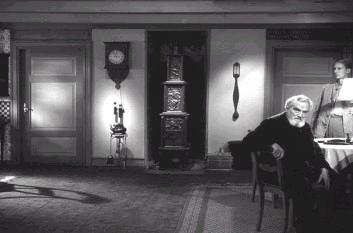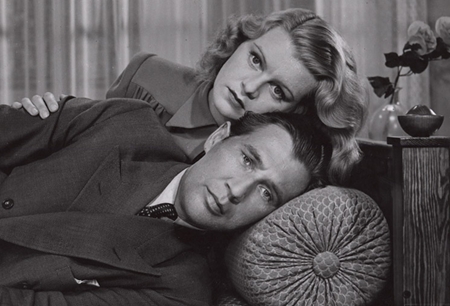From The Guardian (May 30, 2003). –J.R.
For roughly two decades, my three favourite dramatic features have all been the work of the same man — and my favourite among these depends almost entirely on which one I’ve seen most recently. I came to know and love them in reverse order: first the incandescent and subtly erotic Gertrud (1964), discovered in my early 20s shortly after it premiered; then the gut-wrenching Ordet (1955), which I initially hated when I first saw it in my teens, misconstruing its climactic miracle as a tool of religious propaganda; and finally the voluptuous and mysterious Day of Wrath (1943), which I didn’t appreciate or understand until my 40s, when I finally saw it in a decent 35mm print.
Like all the greatest artists, Carl Theodor Dreyer demands to be taken as a figure whose work continues to grow and change, quite irrespective of the fact that he died in 1968 at the age of 79, with many of his most cherished projects (most notably, a film about Jesus) unrealised. Fresh insights about his life and career keep coming to light: not only through biographical research; the emergence of new prints (such as the remarkable 1981 rediscovery of the original 1927 version of The Passion of Joan of Arc in an Oslo mental hospital); but also through the uncanny fact that his films seem to grow more multilayered, ambiguous, and complex over time. Though I’ve never been fortunate enough to attend a Dreyer retrospective, and envy those who’ll soon be able to, I’ve managed to see most of his films several times, and have found that his work seems to become more modern and contemporary with every passing year.
Even after Vampyr (1932), his other best-known film, is added to the four masterpieces cited above, you are still some distance from defining the breadth and range of his work. Who would guess from the various kinds of gloom contained in those films, or the tragic overtones characterising all of them apart from Vampyr, that three of his greatest silent films are basically comedies about the war between the sexes? In their very different ways, The Parson’s Widow (1920) and Master of the House (1925; see below) both involve the humbling of chauvinist husbands by their wives, while the recently restored Once Upon a Time (1922), which starts off as a Lubitsch-style palace farce before turning into a rustic melodrama, runs variations on The Taming of the Shrew. (Only half of the latter survives.)
Yet obstacles in recognising the full measure of Dreyer remain, for ideological as well as practical reasons. An obsessional artist who was an enemy of all institutions, cinematic as well as social, and whose principal theme was intolerance, he invariably gets delivered to us today by institutions — most recently the National Film Theatre, which starts a Dreyer retrospective this month — that can’t always be counted on to represent him in all his complexity. This problem is especially acute in English-speaking countries, where the late Maurice Drouzy’s essential 1982 Dreyer biography, available only in Danish and French, has yet to be translated.
Without this crucial resource – as well as additional discoveries by Drouzy that postdate his biography — various false impressions tend to get recycled and perpetuated. The first biographical sentence of the NFT’s notes contains only one slight error, but this hoary chestnut has already misled several generations of Anglo-American viewers: “Born illegitimately in Copenhagen in 1889 to a poor and abused mother who died painfully two years later, Dreyer endured an arid childhood within a strict Lutheran adoptive family.”
The inaccurate word is “strict”. In fact, Dreyer’s adoptive parents, Carl and Marie Dreyer — a freethinking leftist typesetter and a wife who already had an illegitimate daughter by another man — never set foot inside a church unless they had to, and their adopted son was a non-believer who attended occasional services at a French reform church, but only in order to teach himself the language. Ib Monty — director of the Danish Film Archive and one of the film-maker’s few friends — once told me that Dreyer wasn’t especially religious, despite his frequent recourse to religious themes, and this observation immediately shot down at least half the received notions I had about him at the time. Challenges to belief as well as to disbelief, faith as well as lack of faith, The Passion of Joan of Arc, Vampyr, Day of Wrath, and Ordet all take place in a highly sensuous material world where the mysteries of human personality supersede and arguably overwhelm most questions about the supernatural.
What made Dreyer’s childhood emotionally arid by most accounts was lack of familial affection, partly motivated by his real mother, Josefina Nilsson, a Swedish maidservant, having failed to leave the Dreyers any money for child support. Her accidental and hideously painful death came from sulphur poisoning — swallowing the ends of a box and a half of matches in order to abort a second illegitimate child. Dreyer — who didn’t learn about her fate until he travelled to Sweden, shortly before he turned 19, to discover whatever he could about her — grew up idealising her while despising his adopted mother .
An intensely private person, Dreyer has remained elusive largely because he was so successful in covering his tracks, so that other discoveries about his troubled life — such as Drouzy’s report on his brief phase as a homosexual in the early 1930s, culminating in a nervous breakdown — surfaced over a decade after the publication of his biography.
Quite plausibly (albeit somewhat obsessively in his own right), Drouzy has divided the major women figures in Dreyer’s work between good mothers (most of them suffering saints) and bad mothers (most of them perverted by different forms of intolerance) — with the possible exceptions of the title heroine of Gertrud, who embodies both types simultaneously, and Anne in Day of Wrath, who might be said to undergo a complex social transformation in 17th-century Denmark from guilty saint to innocent witch. (Made during the German occupation, Day of Wrath can be read as a definitive account of 20th-century witch-hunts — which helps to explain why it almost certainly served as a major influence on Arthur Miller’s The Crucible.)
No less significantly, Inger in Ordet dies in childbirth, the saintly Joan of Arc is burnt as a witch, and all these women, along with the lesbian sisters in Vampyr, are entirely carnal beings. (After Inger dies, her father-in-law declares, “She is dead… She is no longer here. She is in heaven,” and his son replies, “Yes, but I loved her body too.”)
According to Drouzy, the key inspiration for Gertrud, based on a play by Hjalmar Söderberg, was Dreyer’s discovery at 73 that Maria von Platen, Gertrud’s real-life counterpart, spent the last years of her life in a house only 10 miles from the site of his own conception. Some of the interiors of this house were meticulously reconstructed for the film’s final scene, an epilogue that Dreyer added to the play.
A comparable kind of personal fixation about origins as well as destinies can be seen coursing through Dreyer’s entire oeuvre, arguably accounting for its slow-burning intensity and many of its formal and stylistic eccentricities as well as its thematic constants. His intransigence about maintaining absolute control over his work largely accounts for why he made so few sound pictures, and the one occasion when he lost that control — over the casting of his two-actor chamber drama Two People (1945) — proved so disastrous that he often refused to acknowledge the film’s existence.
Yet apart from that misstep, it’s hard to think of many film-makers who sustained as high a level, reinventing himself with every feature while obstinately remaining the same. From the lyricism and folksy humour of The Parson’s Widow to the expressionism and bisexuality of Michael (1924), to the feminism of Master of the House, to the stark and spare tragedy of The Passion of Joan of Arc, made respectively in Norway, Germany, Denmark, and France, Dreyer’s silent pictures are remarkable for their mastery of decor, lighting, camera movement, and editing. Concentrate on the way he constructs the space of an interior or orchestrates a sensual camera movement that he invented himself — the camera gliding on unseen tracks in one direction while uncannily panning in another direction — and you perceive how each Dreyer film almost brutally reconstructs the universe rather than accepting it as a familiar given. Nothing can be taken for granted in these works — except their passion.


